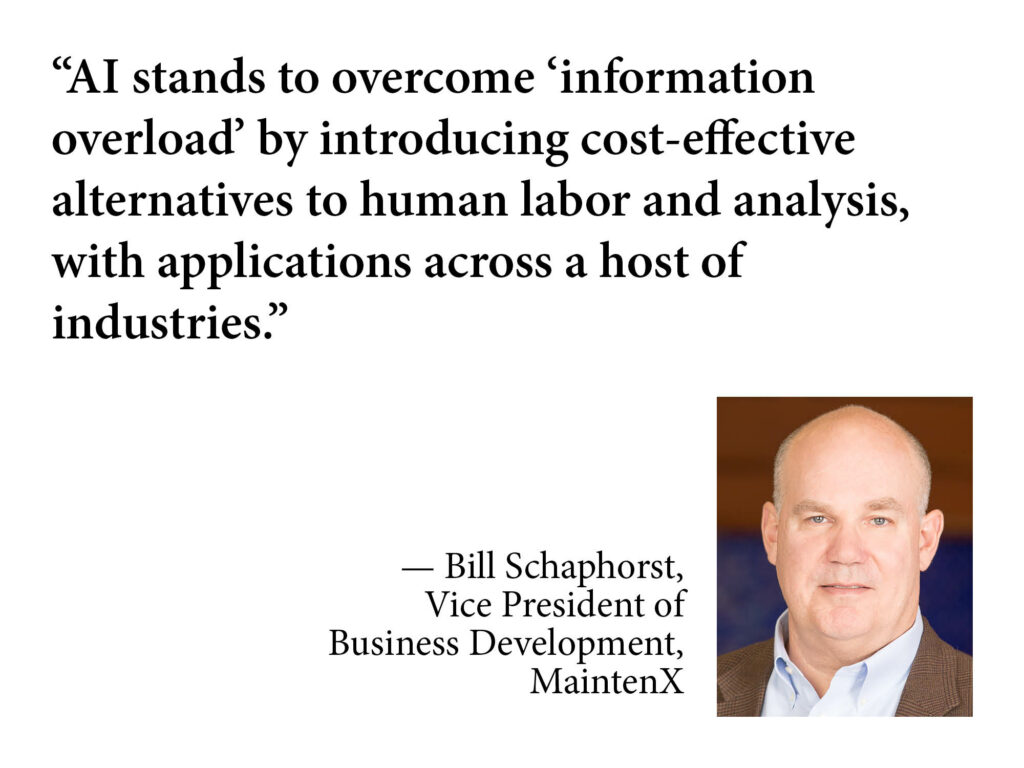Given the high cost of purchasing and running heating, ventilation and air-conditioning equipment, restaurant and retail operators want their HVAC units operating efficiently to minimize utility bills and extend the working life of system components.
In as little as a few years, however, business owners may have a powerful new tool to help meet those goals. This digital aid would not only monitor HVAC performance and alert owners to perform preventive maintenance or needed repairs, but may also suggest subtle operational adjustments or equipment substitutions to boost efficiency and cost savings.
That’s according to Bill Schaphorst, vice president of business development at MaintenX, a facility maintenance and repair provider. We asked the 30-year HVAC industry veteran what developing technologies he expects will have the greatest impact on restaurant and retail operators going forward.
“Artificial intelligence (AI) is the big gorilla in the room, and we’re all wondering how it will change the way we do things,” he says. While AI isn’t integrated into mainstream HVAC systems today, Schaphorst expects some customers will begin using the technology to add notes to their work orders for maintenance and repairs within the next year.
“As soon as somebody comes up with a simple way for AI to tell a restaurant or retailer’s vendors when to show up for repairs and when to perform preventive maintenance, with little action required by the customer, I guarantee you that business owners will want to review the cost of implementation and put it into practice,” Schaphorst predicts.
Ripe for Innovation
Long practice has shown that following a schedule of inspections and preventive maintenance is the best approach to keeping HVAC systems in top condition. MaintenX customers typically arrange for onsite inspections about once per quarter, when technicians will clean or replace filters, lubricate mechanisms and perform other scheduled tasks. MaintenX also uses these opportunities to check for leaks in refrigerant and drainage lines, gauge system performance and identify worn parts that may require repair or replacement.
A key to traditional preventive maintenance is consistency. Lacking the ability to see inside every part of a mechanical system, an owner or service provider reduces the likelihood of HVAC failures by servicing components on a schedule based on experience and prediction. To successfully reduce breakdowns, a responsible human must initiate service visits at the proper time. Likewise, when a technician or business operator notices deteriorating HVAC performance, prompt action to identify and correct the problem can often avoid a full breakdown or more costly repair.
In the past, manufacturers have introduced countless sensors designed to reveal the inner workings of HVAC systems, Schaphorst says. In theory, this would enable customers to clean or replace filters only when dust and dirt reduce airflow below an acceptable threshold. Similarly, data from temperature sensors and ammeters can track gradual declines in the performance or efficiency of electric motors, compressors and other components.
Some sensors are mandatory, such as those manufacturers install to sound an alarm when refrigerants leak. Retail chains or other large, enterprise-scale businesses may even choose to subscribe to HVAC monitoring services. A monitoring service can alert customers when, for instance, a store’s energy usage increases beyond the normal range for the rest of the chain, Schaphorst says.
Historically and today, the drawback to relying on internal sensors to trigger maintenance and repair has been the prohibitive labor cost to analyze mountains of collected data, draw conclusions and translate that information into action, Schaphorst says.
“AI stands to overcome ‘information overload’ by introducing cost-effective alternatives to human labor and analysis, with applications across a host of industries,” Schaphorst says.
“The reason people are making all these predictions about what AI will do is that intelligence — spare intelligence — is being created that will be able to take on that data and do something with it, whereas in the past that data was discarded,” he says.
HVAC on AI
When will that surge in accessible data analysis enable restaurants, retailers and other business owners to fine-tune their HVAC usage and maintenance for ultimate efficiency? Schaphorst cautions that to be cost-effective and industry wide, AI innovations will need to come from manufacturers, which will likely integrate AI capabilities into future generations of rooftop units. In the interim, however, he predicts that enterprising chains leveraging the internet of things could boost their data analysis of those operations using an existing AI product, without waiting for an app specific to the industry. As in all AI integrations, data input and training the tool will be keys to its success, he says.
“Once it’s implemented and properly trained,” Schaphorst predicts, “we could see an AI tool start initiating those actions that, in the past, companies just didn’t have the time and the expertise to calculate and perform.”
For smaller chains, store owners and restaurants, tracking HVAC systems with AI is unlikely to be a cost-effective strategy in the near term. With or without AI, businesses can safeguard against most system failures with a solid preventive maintenance program administered by an experienced, trusted service provider able to resolve unexpected problems quickly.
— By Matt Hudgins. MaintenX is a content partner of Retail & Restaurant Facility Business. For more articles from and news about MaintenX, click here.
